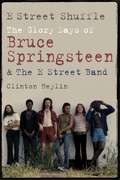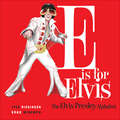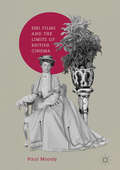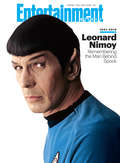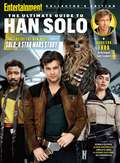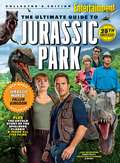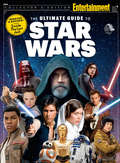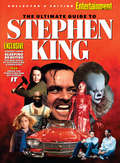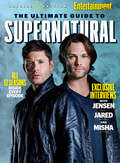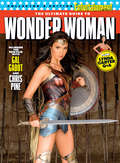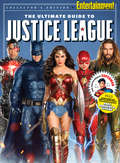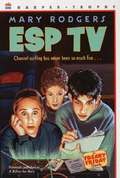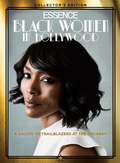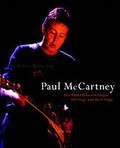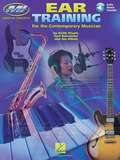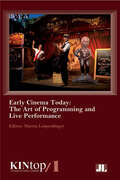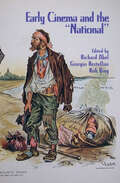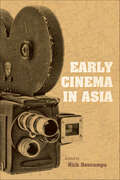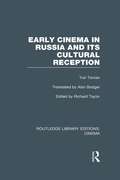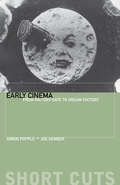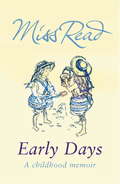- Table View
- List View
E Street Shuffle: The Glory Days of Bruce Springsteen and the E Street Band
by Clinton HeylinBruce Springsteen is one of the most important and controversial rock stars of our times: this is the story of the man - a complex, poetic loner whose albums went on to sell 18 million copies - and the band that gave his inner vision a punch and a swagger. Clinton Heylin has written the most factually accurate, informative book on Springsteen to date. As in Heylin's definitive Bob Dylan title Revolution in the Air, E Street Shuffle will focus on Bruce Springsteen and his work: the songs he's written, the way they were recorded, how they sounded live. Heylin also has unparalleled access to the people around Springsteen: current and former members of the E Street Band; CBS A&R personnel; Springsteen's 'New Dylan' contemporaries, as well as fellow Asbury Park musicians and scenesters, and rock critics. This is the essential book for any fan of the Boss.Praise for Clinton Heylin:"Arguably the world's greatest rock biographer." - The Irish Independent."The only Dylanologist worth reading." - The New York Times.
E is for Elvis: The Elvis Presley Alphabet
by Ivey Dickinson Rand WiremanAn irreverently funny and delightfully illustrated alphabet book that explores the life and legacy of Elvis Presley from A to Z.Elvis fans of all ages will delight in this witty and revealing look at the King of Rock and Roll. Endlessly entertaining and surprisingly informative, E is for Elvis is essential reading for any Elvis aficionado. Every page is filled with amusing anecdotes, little known facts, and lively illustrations that explain why “G” is for Graceland, “J” is for Jeweled Jumpsuits, “V” is for Vegas, and “O” is for overweight . . .
EMI Films and the Limits of British Cinema
by Paul MoodyThis book is the first of its kind to trace the development of one of the largest and most important companies in British cinema history, EMI Films. From 1969 to its eventual demise in 1986, EMI would produce many of the key works of seventies and eighties British cinema, ranging from popular family dramas like The Railway Children (Lionel Jeffries, 1970) through to critically acclaimed arthouse successes like Britannia Hospital (Lindsay Anderson, 1982). However, EMI’s role in these productions has been recorded only marginally, as footnotes in general histories of British cinema. The reasons for this critical neglect raise important questions about the processes involved in the creation of cultural canons and the definition of national culture. This book argues that EMI’s amorphous nature as a transnational film company has led to its omission from this history and makes it an ideal subject to explore the ‘limits’ of British cinema.
EN ALAS DE LA SEDUCCION (EBOOK)
by Gloria V. CasañasEn un rincón remoto de la Patagonia Argentina, un hombre se oculta del mundo y, sobre todo, de su pasado. Newen Cayuki, por cuyas venas corre la sangre de los bravos indios tehuelche, sabe que los dioses le han negado todo, incluido el amor. Pero no imagin nunca que la maldición tomaría la forma de una hermosa mujer blanca, ni que su encarnizada lucha contra ella acabaría en la derrota más dulce, la de la rendición por amor. Cordelia no tiene otro propósito, al llegar a ese lugar en el fin del mundo, que ayudar a su querido hermano gemelo. Llevada por su audacia, pensó que la misión sería fácil, pero no contaba con la presencia imponente de aquel bárbaro que la intimida, la repudia y parece odiarla por alguna oscura razón. Sólo la magia ancestral de los antiguos, bajo la sombra de las alas del cóndor de los Andes, podría desenredar la maraña de los sentimientos que ata los corazones.
ENTERTAINMENT WEEKLY Leonard Nimoy, 1931-2015: Remembering the Man Behind Spock
by The Editors of Entertainment WeeklyEntertainment Weekly presents a tribute to Leonard Nimoy. Star Trek's Spock - and much more
ENTERTAINMENT WEEKLY The Ultimate Guide to Han Solo
by The Editors of Entertainment WeeklyUnlike Luke, Leia and even Darth Vader, he has remained Star Wars' most intriguing enigma. Now, 41 years after he first appeared onscreen, the real Han Solo is about to be revealed. In ENTERTAINMENT WEEKLY The Ultimate Guide to Han Solo go inside the new movie Solo: A Star Wars Story.
ENTERTAINMENT WEEKLY The Ultimate Guide to Jurassic Park
by The Editors of Entertainment WeeklyCelebrate the 25th anniversary of the first Jurassic Park film in this Entertainment Weekly special edition, The Ultimate Guide to Jurassic Park.
ENTERTAINMENT WEEKLY The Ultimate Guide to Star Wars Updated & Revised: Inside The Last Jedi
by The Editors of Entertainment Weekly"A long time ago, in a galaxy far, far away," 10 words changed the cinematic world forever. Now Entertainment Weekly's editors and writers celebrate the Star Wars universe in an updated and revised collector's edition - Entertainment Weekly The Ultimate Guide to Star Wars - that covers the entire universe, from A New Hope to The Last Jedi, and all the books, television shows, comics and video games in between. This comprehensive guide features rarely seen production and cast photos from all the movies in the series, including behind-the-scenes photos from The Last Jedi, as well as surprising reveals and speculation about the future of the franchise.There are tons of extras throughout for Star Wars-obsessed fans, including an essay on illustrator Ralph McQuarrie, the founding of George Lucas's Industrial Light & Magic, the secrets hidden within John Williams's scores, a tribute to director Irvin Kershner written by his son, and a moving tribute to Carrie Fisher by Mark Hamill, as well as insights on what Fisher's unexpected death means for the final film and a discussion about what's to come in 2018's Solo: A Star Wars Story. Also included are deep dives focusing on insider-only content like the Holiday Special, spoofs and parodies, a discussion about the now-retired Legends books and comics series, and a discussion about proper viewing order. This is the must-have edition for anyone and everyone who considers themselves a Star Wars fan.
ENTERTAINMENT WEEKLY The Ultimate Guide to Stephen King
by The Editors of Entertainment WeeklyIncludes an exclusive excerpt from Sleeping Beauties-the new novel by Stephen King and Owen King!There are few writers today who have influenced popular culture more than Stephen King, from his iconic novels and stories to the movies that have been inspired by them, including Carrie, The Shining, Misery, Stand By Me, It, Cujo, The Green Mile, The Shawshank Redemption, and so many more. Now, in this all-new special edition from Entertainment Weekly, The Ultimate Guide to Stephen King, you'll be able to delve into the world of the master storyteller: Go behind the scenes to find out exactly how King's stories travel from page to screen. We list his greatest and scariest hits, and his 25 scariest moments from his movies, and we examine his many compelling heroines, and why so many of his novels feature "nasty women." Additionally, we list all of the works the godfather of horror has written, as well as the notable movies and television shows derived from his short fiction. Lavishly illustrated with art by Robert Sammelin, and filled with photos from his life, his movies, and his book covers, The Ultimate Guide to Stephen King is a must-have for every fan of this beloved writer.
ENTERTAINMENT WEEKLY The Ultimate Guide to Supernatural
by The Editors of Entertainment WeeklySaving people and hunting demons: It's the family businessFor 12 seasons, no demon, ghost nor monster has been safe from Sam and Dean Winchester, the daring brothers and heroes of hit television show Supernatural. Combining elements of horror, thriller, drama and comedy, this fan favorite explores the world of the paranormal, with brief forays into heaven and hell-and family relationships-every week. As the longtime hit from the CW enters its lucky 13th season, now is the time to time to catch up with an all-new special edition from Entertainment Weekly, The Ultimate Guide to Supernatural. Packed with photographs from each season, a who's who of heaven and hell, and a full episode guide to all 12 seasons-plus exclusive interviews with stars Jensen Ackles, Jared Padalecki and Misha Collins, along with a guide to the guest stars, the top 10 guests, and our expert ranking of each and every episode, this is a must-have for all Supernatural fans. There's even a superfan set-visit diary from S.E. Hinton, the renowned author of The Outsiders. You should pick up your copy now . . . because you always have a choice.
ENTERTAINMENT WEEKLY The Ultimate Guide to The Walking Dead
by The Editors of Entertainment WeeklyWalking Deadheads. Either you are one or you know one. Now in its seventh season, "The Walking Dead" has gone from cult hit to cultural movement and has now achieved the status of appointment television. Mostly because of one simple word - community: This is a show about a tight community made by a tight community for a tight community, and part of its simple appeal is that it makes us face the most basic questions about who we'd become in an extreme world, and who would be there with us.Now, in an all-new collector's edition, Entertainment Weekly takes readers into the writing room, behind the scenes and onto the sets in The Ultimate Guide to The Walking Dead. Go inside each season with exclusive photographs, interviews with the cast and crew, a season-by-season recap, as well as original art that traces the journey of survivors in the series, created by the artists who draw The Walking Dead comic books. Additionally, this collector's edition has two front covers, one of the living, and one of the undead (you should probably collect them both!).With exclusive insights into season 7, special sidebars, as well as an original essay on Why We Love Zombies, The Ultimate Guide to The Walking Dead is the drop un-dead companion to one of the hottest shows on television today.
ENTERTAINMENT WEEKLY The Ultimate Guide to Wonder Woman
by The Editors of Entertainment WeeklyAt 75, DC Comics's Amazonian princess is finally getting her own movie, and EW is celebrating with a gorgeously illustrated issue devoted entirely to Wonder Woman-from her groundbreaking girl-power comic book debut to the beloved 1970s TV show starring Lynda Carter to Gal Gadot's action-star spin on the first superheroine. Inside:The making of the new film Wonder Woman, with behind-the-scenes photos and interviews with stars Gal Gadot, Chris Pine, Robin Wright and Connie Nielsen and director Patty JenkinsLynda Carter talks about her pioneering TV role and the meaning of Wonder WomanThe evolution of Wonder Woman's look, from prim skirts to go-go boots to modern-day armorThe surprising story of Wonder Woman's creator-the man who dreamed up her Golden Lasso of Truth also invented the lie-detector test!Plus: The most memorable WW plots of all time
ENTERTAINMENT WEEKLY The Ultimate Guide to the Justice League
by The Editors of Entertainment WeeklyThe League's finally all here to-what else? Save the world.Justice League has arrived. One of the most formidable collections of superheroes the world has ever known is together on the big screen. Entertainment Weekly takes you behind the scenes and onto the set, including exclusive interviews with the cast and creators, in this all-new collector's edition, The Ultimate Guide to Justice League. They're all here-Batman, Wonder Woman, Aquaman, Cyborg, the Flash and, yes, Superman-with character profiles, concept art, costumes, origin stories and more. Stuffed with insider information, including a history of the Justice League in comic-book form and a discussion of each superhero's or -heroine's past and future on the big screen, this comprehensive guide will delight readers of all ages. Interviews with the cast, including Gal Gadot, Ben Affleck, Jason Momoa, Ezra Miller, Ray Fisher and Henry Cavill, are featured. It's time to join the battle for the future of the world!
ESP TV
by Mary RodgersPreviously published as "A Billion for Boris" Annabel Andrews is back in her body, but life is still anything but normal. When her brother, Ape Face, and her boyfriend, Boris, discover a TV that airs its programs a day early, they're suddenly faced with lots of opportunities. Boris wants to make billions of dollars, but Annabel wants to help mankind. They've got to decide what to do before someone figures out what's going on.
ESSENCE Black Women in Hollywood: A Salute to Trailblazers at the Oscars
by The Editors of EssenceThe bold and the beautifulFrom the moment that Hattie McDaniel won Best Supporting Actress for her portrayal of Mammy in Gone With the Wind (1939), a new course for African American women in Hollywood was set. Though, for this great achievement, it would be 63 years before another African American woman-Halle Berry-would claim the trophy for Best Actress. Black Women in Hollywood: A Salute to Trailblazers at the Oscars, the new Collector's Edition from ESSENCE, is a visual chronicle of the strides that African American actresses have made in Hollywood. From the early pioneers like Ethel Waters and Juanita Moore to the leading lights of the 70s and 80s, such as Cicely Tyson, Diahann Carroll and Diana Ross, and to the stars that rock the red carpet today, including Taraji P. Henson, Lupita Nyong'o and Viola Davis. We feature the nominees and the winners on-set, on the red carpet and in their own words-including the inspiring acceptance speeches of each of the winners. And of course, the photographs: dozens of pictures showcasing these trailblazers on the red carpet, in the roles that won them nominations, and even relaxing at home. Black Women in Hollywood is both a walk down memory lane and an inspirational reminder: to dream bigger than you could have ever imagined.
EU Promotion of Human Rights for LGBTI Persons in Uganda: Translating and Organizing a Wicked Problem
by Lydia MalmedieExamining the EU's promotion of human rights for lesbian, gay, bisexual, trans+ and intersex (LGBTI) persons in Uganda during the period of 2009 to 2017, this book investigates how a public administration defines and deals with a wicked problem. The empirical puzzle of how the topic of human rights for LGBTI persons, despite its highly contested nature, travelled between Brussels and Kampala, became codified in form of LGBTI Guidelines (2013) and institutionalized within EU foreign policy is addressed as one of translation and sensemaking. The investigation focuses on the process of problem definition in everyday practice by EU staff and EU member states’ staff in Brussels and Kampala. This book therefore provides key insights into how public administrations deal with wicked problems, how contested ideas can become institutionalized and how an idea is translated and made sense of across time, levels and cultural boundaries. The findings are of interest especially to scholars of wicked problems, sociological new institutionalism and public administration as well as international relations and EU studies, human rights, gender and sexuality studies.
Each One Believing: On Stage, Off Stage, and Backstage
by Paul MccartneyFans of McCartney will relish this volume of photos and interviews recording the singer's record-breaking 2002-2003 world tour. The text is taken from interviews and conversations filmed during the tour. Annotation ©2004 Book News, Inc., Portland, OR (booknews.com)
Ear Training: The Complete Guide For All Musicians
by Joe Elliott Wyatt Keith Carl J. Schroeder Keith WyattThis book takes you step by step through MI's well-known Ear Training course. Complete lessons and analysis include: basic pitch matching * singing major and minor scales * identifying intervals * transcribing melodies and rhythm * identifying chords and progressions * seventh chords and the blues * modal interchange, chromaticism, modulation * and more! Learn to hear and to visualize on your instrument. Take your playing from good to great! Over 2 hours of practice exercises with complete answers in the back.
Early Cinema Today, KINtop 1: The Art Of Programming And Live Performance (KINtop #1)
by Martin LoiperdingerInvented in the 1890s and premiered in Paris by the Lumière brothers, the cinematograph along with Louis Le Prince's single-lens camera projector are considered by film historians to be the precursors to modern-day motion picture devices. These early movies were often shown in town halls, on fairgrounds, and in theaters, requiring special showmanship skills to effectively work the equipment and entertain onlookers. Within the last decade, film archives and film festivals have unearthed this lost art and have featured outstanding examples of the culture of early cinema reconfigured for today's audiences.
Early Cinema and the "National"
by Richard Abel, Giorgio Bertellini and Rob KingEssays on “how motion pictures in the first two decades of the 20th century constructed ‘communities of nationality’ . . . recommended.” —ChoiceWhile many studies have been written on national cinemas, Early Cinema and the “National” is the first anthology to focus on the concept of national film culture from a wide methodological spectrum of interests, including not only visual and narrative forms, but also international geopolitics, exhibition and marketing practices, and pressing linkages to national imageries.The essays in this richly illustrated landmark anthology are devoted to reconsidering the nation as a framing category for writing cinema history. Many of the 34 contributors show that concepts of a national identity played a role in establishing the parameters of cinema’s early development, from technological change to discourses of stardom, from emerging genres to intertitling practices. Yet, as others attest, national meanings could often become knotty in other contexts, when concepts of nationhood were contested in relation to colonial/imperial histories and regional configurations. Early Cinema and the “National” takes stock of a formative moment in cinema history, tracing the beginnings of the process whereby nations learned to imagine themselves through moving images.
Early Cinema in Asia
by Nick DeocampoEarly Cinema in Asia explores how cinema became a popular medium in the world's largest and most diverse continent. Beginning with the end of Asia's colonial period in the 19th century, contributors to this volume document the struggle by pioneering figures to introduce the medium of film to the vast continent, overcoming geographic, technological, and cultural difficulties. As an early form of globalization, film's arrival and phenomenal growth throughout various Asian countries penetrated not only colonial territories but also captivated collective states of imagination. With the coming of the 20th century, the medium that began as mere entertainment became a means for communicating many of the cultural identities of the region's ethnic nationalities, as they turned their favorite pastime into an expression of their cherished national cultures. Covering diverse locations, including China, India, Japan, Philippines, Malaysia, Thailand, Iran, and the countries of the Pacific Islands, contributors to this volume reveal the story of early cinema in Asia, helping us to understand the first seeds of a medium that has since grown deep roots in the region.
Early Cinema in Russia and its Cultural Reception (Routledge Library Editions: Cinema)
by Yuri TsivianThis book examines the development of cinematic form and culture in Russia, from its late nineteenth-century beginnings as a fairground attraction to the early post-Revolutionary years. The author traces the changing perceptions of cinema and its social transition from a modernist invention to a national art form. He explores reactions to the earliest films from actors, novelists, poets, writers and journalists. His richly detailed study of the physical elements of cinematic performance includes the architecture and illumination of the cinema foyer, the speed of projection and film acoustics. In contrast to standard film histories, this book focuses on reflected images: rather than discussing films and film-makers, it features the historical film-goer and early writings on film. The book presents a vivid and changing picture of cinema culture in Russia in the twilight of the tsarist era and the first decades of the twentieth century. The study expands the whole context of reception studies and opens up questions about reception relevant to other national cinemas.
Early Cinema: From Factory Gate to Dream Factory (Short Cuts)
by Simon Popple Joe KemberThis book introduces the reader to the study of cinema as a series of aesthetic, technological, cultural, ideological and economic debates while exploring new and challenging approaches to the subject. It explores the period 1895 to 1914 when cinema established itself as the leading form of visual culture among rapidly expanding global media, emerging from a rich tradition of scientific, economic, entertainment and educational practices and quickly developing as a worldwide institution.
Early Days
by Miss ReadThe enchanting childhood memoirs of bestselling author Miss Read.Miss Read's early days were spent with two remarkable grandmothers - one in Lewisham and one in Walton-on-the-Naze. EARLY DAYS is full of childhood memories of an extended family of uncles, aunts and cousins and their houses full of mystery and adventure, where Miss Read spent so much time, living in the shadow of the First World War.At the age of seven, Miss Read moved to the small village of Chelsfield, Kent, into a magical new world - and so began her love of the English countryside which was to have such a strong influence on her career as a writer. Her evocative descriptions of the village school, the joys of exploring the woods and lanes rich in wildlife and of childhood events, from toffee-making to the treat of a lift on the corn-chandler's cart, vividly convey this time as one of the happiest of her life.
Early Days
by Miss ReadThe enchanting childhood memoirs of bestselling author Miss Read.Miss Read's early days were spent with two remarkable grandmothers - one in Lewisham and one in Walton-on-the-Naze. EARLY DAYS is full of childhood memories of an extended family of uncles, aunts and cousins and their houses full of mystery and adventure, where Miss Read spent so much time, living in the shadow of the First World War.At the age of seven, Miss Read moved to the small village of Chelsfield, Kent, into a magical new world - and so began her love of the English countryside which was to have such a strong influence on her career as a writer. Her evocative descriptions of the village school, the joys of exploring the woods and lanes rich in wildlife and of childhood events, from toffee-making to the treat of a lift on the corn-chandler's cart, vividly convey this time as one of the happiest of her life.
